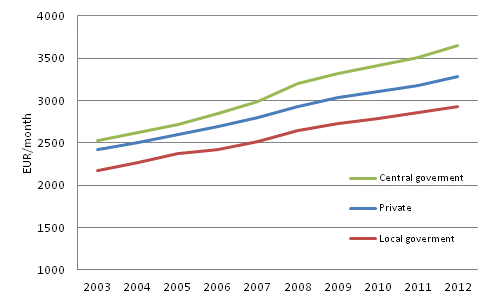Published: 11 October 2013
Central government average earnings have grown most among employer sectors from 2003 to 2012
According to Statistics Finland’s Structure of Earnings statistics, the average monthly earnings of full-time wage and salary earners were EUR 3,206 in the last quarter of 2012 and the median earnings were EUR 2,853. In the central government sector, the average earnings of full-time wage and salary earners were EUR 3,647, in the local government sector EUR 2,932, and in the private sector EUR 3,279. Between 2003 and 2012, average earnings grew by 44 per cent in the central government sector and by 35 per cent in both the local government sector and the private sector.
Change in earnings by employer sector in 2003 to 2012

According to the comparison by occupational group, average earnings have grown more in the central government sector than in the other employer sectors in almost all occupational groups. Earnings have grown particularly for managers, professionals and associate professionals. The change in average earnings in the local government sector has been more considerable than in the private sector in several occupational groups.
Change in earnings according to occupational category by employer sector in 2003 to 2012
| Classification of Occupations 2010 | Change in average total earnings, percent | ||
| Private sector | Local government | Central government | |
| Total | 35 | 35 | 44 |
| 1 Managers | 44 1) | 42 | 52 |
| 2 Professionals | 29 | 35 | 46 |
| 3 Technicians and associate professionals | 32 | 37 | 50 |
| 4 Clerical support workers | 30 | 35 | 45 |
| 5 Service and sales workers | 34 | 31 | 40 |
| 6 Skilled agricultural, forestry and fishery workers | 32 | 43 | 48 |
| 7 Craft and related trades workers | 32 | 30 | 36 |
| 8 Plant and machine operators, and assemblers | 33 | 22 | 21 |
| 9 Elementary occupations | 24 | 25 | 33 |
In the statistics on wages and salaries, universities moved from the central government sector to the private sector in 2010 as a result of the university reform. This slightly raises the growth percentage for average earnings in the central government sector, but has no effect on the trend of the pay development between the sectors. Appendix table 1 includes changes in average earnings by occupational group and employer sector so that universities are part of the central government sector in 2010 to 2012.
The data of this release derive from Statistics Finland’s Structure of Earnings statistics, which cover all employer sectors. Monthly earnings for total hours worked are only calculated for full-time wage and salary earners. Besides earnings for regular working hours, the earnings also include pay for any possible overtime and working hour supplements but not one-off pay items, such as performance-based bonuses.
Source: Structure of Earnings 2012, Statistics Finland
Inquiries: Sampo Pehkonen 09 1734 3452, Mika Idman 09 1734 3445, palkkarakenne@stat.fi
Director in charge: Hannele Orjala
Publication in pdf-format (244.4 kB)
- Reviews
- Tables
-
Tables in databases
Pick the data you need into tables, view the data as graphs, or download the data for your use.
Appendix tables
Updated 11.10.2013
Official Statistics of Finland (OSF):
Structure of Earnings [e-publication].
ISSN=1799-0092. 2012. Helsinki: Statistics Finland [referred: 19.4.2025].
Access method: http://stat.fi/til/pra/2012/pra_2012_2013-10-11_tie_001_en.html

